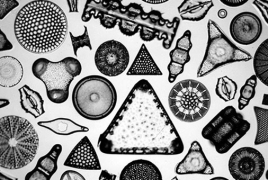Carl Strüwe’s 1st solo exhibit in U.S. since 1949 opens at Kasher Gallery April 18, 2016 - 15:52 AMT PanARMENIAN.Net - The Steven Kasher Gallery is presenting Carl Strüwe: Microcosmos, the first solo exhibition of the German photographer in the United States since his 1949 solo show at the Brooklyn Museum, Art Daily reports. This survey features over 50 black and white prints made by the artist of his microphotographs from 1926 through 1959, all part of his project Formen des Mikrokosmos (Forms of the Microcosmos). A graphic designer and photographer, Carl Strüwe (1898-1988) is considered the father of microphotography as art. He deserves to be rediscovered as a significant protagonist of early twentieth-century German photography and as an important link to the international abstract photography so widely practiced today. This exhibition is mounted in conjunction with our concurrent show Gottfried Jäger: Photographer of Photography. Jäger was deeply influenced by Strüwe and owns the Strüwe archive. A self-taught photographer, Carl Strüwe made his first photograph through a microscope, called White Suspended over Grey, in 1926. This is the beginning of his three-decade artistic masterpiece: Formen des Mikrokosmos, which resulted in a set of 280 microphotographs, and in a 1955 book of that name. He did his last microphotograph, Finale, in 1959. Starting in 1927, microphotographs by Strüwe were published in important avant-garde magazines including Atlantis (Berlin), Arts et Metiers Graphiques (Paris), graphis (Zurich), and striven (Amsterdam). Strüwe had his first solo show in 1947, followed by 15 solo shows in Germany, France, and the United States. Carl Strüwe was included in iconic exhibitions: the first edition of photokina in 1950, the 1951 Subjektive Fotografie curated by Otto Steinert and The New Landscape in Art and Science organized by Gyorgy Kepes at MIT, also in 1951. Carl Strüwe did not present microphotography as scientific evidence. Rather than using the usual circular image produced by the microscope he innovated a rectangular lens frame based on the standard Western format for painting and drawing. Strüwe’s photographs emphasized the basic geometric structures of microscopic organic life. He portrayed the microcosm as an abstract world similar to the images of Cubism and Constructivism. Carl Strüwe’s artistic microphotographs of the 1920s are associated with the New Objectivity of Albert Renger-Patzsch (Die Welt ist schön) and Karl Blossfeldt (Urformen der Kunst). While Renger-Patzsch dealt with whole scenes and Blossfeldt with plant details, Strüwe pushed the vision of the New Objectivity one step further, into the invisible world. In the postwar period he made montages that used experimental techniques such as multiple exposure and solarisation, in tandem with younger photographers associated with the Subjektive Fotografie movement of the 1950s. For Strüwe’s 1949 solo show at the Brooklyn Museum the press release stated that Strüwe’s photographs “often remind us of modern artists such as Klee or Kandinsky and yet they do not encroach upon the field of painting. Rather they suggest possible sources and explanations for modern abstract art, unearthing a whole world of beauty invisible to the naked eye.” In the introduction to his 1955 book, Strüwe cited Fernand Leger, Paul Klee, Willi Baumeister and Paul Cezanne as other artists advocating “to study sphere, cone and cylinder.” In 1945 bombs destroyed Strüwe’s studio in Bielefeld. He lost most of his photographic prints. In his later years Strüwe participated in numerous exhibitions and publications. In 1982 a retrospective on his work was shown at the Waldhof Cultural History Museum in Bielefeld, his native town. In 1986 he received the Cultural Award of Bielefeld. Carl Strüwe died on January 7, 1988. In 2012 the Bielefelder Kunstverein mounted an exhibition Carl Strüwe in the Context of Contemporary Photography that pointed out the relevance of Carl Strüwe’s work for contemporary artists such as Liz Deschenes, Jan Paul Evers and Jochen Lempert. A monograph about his life's work was published in 1982; published in 2011 was Gottfried Jäger’s Microphotography as Obsession: The Photographic Work of Carl Strüwe (1898-1988). Carl Strüwe’s photographs are held in the permanent collections of major art institutions including the Brooklyn Museum, New York; J. Paul Getty Museum, Los Angeles; the National Gallery of Canada, Ottawa; the Stedelijk Museum, Amsterdam; the Museum Ludwig, Cologne; the Museum für Kunst und Gewerbe, Hamburg; and the Kunsthalle, Bielefeld. Photo: Steven Kasher Gallery, New York The creative crew of the Public TV had chosen 13-year-old Malena as a participant of this year's contest. She called on others to also suspend their accounts over the companies’ failure to tackle hate speech. Penderecki was known for his film scores, including for William Friedkin’s “The Exorcist”, Stanley Kubrick’s “The Shining”. The festival made the news public on March 19, saying that “several options are considered in order to preserve its running” Partner news |